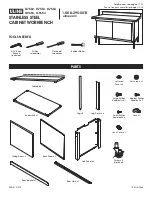
HYDRA SD Max Storage Card User Manual Sample
16
Figure 9.0 – HYDRA SD Max software / hardware model.
5.0 Interfacing to the HYDRA SD Max Card
In this section we’ll discuss interfacing to the SD card at all levels; electrical to FAT16. Referring to Figure 9.0 above you
can see that the SD card software / hardware model looks a little like the 7-layer OSI model for networking. There is the
application layer
at the top. Then under it is the
FAT16 file system
which facilitates interfacing the SD card with the PC
(optional). Next down is the
SD card protocol layer
which is what the SD card speaks and gives access to the internal
controller in the SD card as well as raw sector reads and writes. This is followed by the actual communication layer to the
SD card which is a
SPI interface
consisting of 4-lines; data out, data in, clock, and chip select. Then finally where the
rubber metal the concrete are the
electrical connections
to the Propeller chip itself that we can toggle via port I/O
commands. Thus, we have to implement every single one of these layers, so we have our work cut out for us!
Our goal is to become familiar with writing a SPI driver all the way up to a DOS/Windows compliant FAT16 file system.
There is a lot of material to cover on the these subjects and each warrants a lot of information, so I suggest referring to
the related links and documents on the CD for more in depth coverage. Take a look in these sub-directories for a number
of relevant documents:
CD_ROM:\DOCS\
\FAT - Documents about the FAT file system.
\SD - Documents about the SD card protocol and design in general.
\SPI - Documents about the SPI interface and protocol.
But, before we begin let’s take an aside briefly and talk about some of the history and design of the SD card protocol.
Содержание HYDRA SD MAX
Страница 1: ......







































